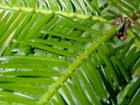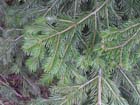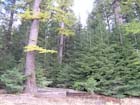Abies grandis
(Douglas ex D. Don) Lindley 1833
Common names
Grand, lowland, white, silver, yellow or stinking fir (Peattie 1950), sapin grandissime [French] (Hunt 1993).
Taxonomic notes
Syn: A. amabilis Murr. not Forbes, A. excelsior Franco, A. gordoniana Carr. (Vidakovic 1991), Pinus grandis Douglas ex D. Don 1832 (Hunt 1993).
This species displays some interesting morphological variation. Some authorities discriminate populations east and west of the Cascade crest as Abies grandis var. grandis and Abies grandis var. idahoensis Silba 1990 (syn.: Abies grandis subsp. idahoensis Silba 2008). The distinction between the two varieties, although not generally remarked in the American literature, has been known for a long time in Britain from provenance trials (Lines 1979), which showed that trees from coastal origins grow about twice as fast as those from interior origins, the latter being similar to A. concolor in growth rate. There are also some foliage and cone differences; var. grandis has very flat shade foliage, whereas var. idahoensis has more assurgent shade foliage (similar to that of A. concolor var. lowiana). Also, var. grandis has slightly more slender cones with thinner, less woody scales (M. Frankis e-mail 2009.07.12). The varieties do not show any significant differences in leaf essential oil composition, a finding borne out by three independent studies (Adams et al. 2015). Most modern authorities, however, find the putative differences small enough, with characters sufficiently overlapping, that the varieties are reduced to synonymy with the type.
Near its southern range limits (see range map below), A. grandis introgresses A. concolor var. lowiana; populations of such trees (A.concolor × A. grandis) are sometimes called "Abies grandicolor," though that name has not been formally described. See further notes on this phenomenon below.
Description
Trees to 75 m tall and 155 cm dbh; "crown conic, in age round topped or straggly. Bark gray, thin to thick, with age becoming brown, often with reddish periderm visible in furrows bounded by hard flat ridges. Branches spreading, drooping; twigs mostly opposite, light brown, pubescent. Buds exposed, purple, green, or brown, globose, small to moderately large, resinous, apex round; basal scales short, broad, equilaterally triangular, slightly pubescent or glabrous, resinous, margins entire, apex pointed or slightly rounded. Leaves (1)2-6 cm × 1.5-2.5 mm, 2-ranked, flexible, with leaves at center of branch segment longer than those near ends, or with distinct long and short leaves intermixed, proximal portion ± straight, leaves higher in tree spiraled and 1-ranked; cross section flat, grooved adaxially; odor pungent, faintly turpentinelike; abaxial surface with 5-7 stomatal rows on each side of midrib; adaxial surface light to dark lustrous green, lacking stomates or with a few stomates toward leaf apex; apex distinctly notched (rarely rounded); resin canals small, near margins and abaxial epidermal layer. Pollen cones at pollination bluish red, purple, orange, yellow, or ± green. Seed cones cylindric, (5)6-7(12) × 3-3.5 cm, light green, dark blue, deep purple, or gray, sessile, apex rounded; scales ca. 2-2.5 × 2-2.5 cm, densely pubescent; bracts included. Seeds 6-8 × 3-4 mm, body tan; wing about 1.5 times as long as body, tan with rosy tinge; cotyledons (4)5-6(7). 2n=24" (Hunt 1993).
The essential differences between A. grandis and A. concolor, which serve to identify introgressed populations, concern stomata and the "sawtooth". A. grandis contains no or very few and distal stomata on the adaxial (upper) leaf surface, while A. concolor has abundant stomata that nearly cover the adaxial leaf surface. Intermediate conditions identify hybrids; Zobel (1973) found that "either 'maximum number of adaxial stomatal rows' or 'percentage of length of needle with adaxial stomata' can be used to describe the extent of adaxial stomata." The "sawtooth" refers to the strong tendency in A. grandis for needles along one side of the twig to alternate in length, short to long to short, as shown in the photos at right. This phenomenon is uncommon in A. concolor. Zobel (1973) also notes a variation in leaf apex, from distinctly notched in A. grandis to obtuse or shallowly notched in A. concolor. The "sawtooth" sometimes also occurs in A. amabilis, which may occur near A. grandis in some areas such as the northern Olympic peninsula; however A. amabilis also has some needles dorsal to the twig, which is never seen in A. grandis.
Distribution and Ecology
Canada: British Columbia; USA: Montana, Idaho, Washington, Oregon and California at 0-1500 m in moist conifer forests (Hunt 1993). Hardy to Zone 6 (cold hardiness limit between -23.2°C and -17.8°C) (Bannister and Neuner 2001). See also Thompson et al. (1999).
Distribution of Abies concolor var. concolor (blue), A. concolor var. lowiana (red), A. grandis (orange), and A. grandis x concolor hybrids (purple). Data downloaded 2020.11.13 from GBIF and the Consortium of Pacific Northwest Herbaria; see description in map (click on tray icon) for further detail; click on points for further data.
Within the zone of introgression to A. concolor, individual populations may contain trees displaying characters ranging from very good coastal A. grandis to Sierra Nevada-typical A. concolor var. lowiana. Zobel (1973) studied a gradient of hybrid populations from true A. grandis to nearly true A. concolor and found that "low-elevation populations west of the Cascade crest, mostly on river terraces, resemble A grandis. High-elevation west-side populations, disjunct from those at low elevations and occupying ridge tops and steep, dry slopes, include trees with some traits of A. concolor. Populations on the east flank of the Cascades show a greater but widely variable influence of A. concolor. East-side populations vary locally with aspect, being most like A. grandis on north slopes, but they do not clearly vary with elevation. Incidence of characteristics resembling A. concolor increases from north to south." Ott et al. (2015) showed that the hybrid populations occupy a distinctly different ecological niche than either A. grandis or A. concolor, identifying two distinct hybrid classes that "occupy distinct habitats that are variably intermediate between those associated with A. grandis and A. concolor for a majority of environmental variables, but with lower precipitation in the summertime in the southern Cascade, Siskiyou, and Sierra Nevada Mountains than associated with either progenitor. We hypothesize that moisture stress and high levels of solar insolation in the summertime associated with hybrid populations have played an important role in the observed patterns of introgression of key traits: leaf angle, specific leaf area, and abundance of adaxial stomates." This is consistent with the finding by Zobel (1974) that hybrid populations of the eastern Cascades experience lower summer moisture stress than A. grandis of the western Cascades, despite occurring on sites with more xeric vegetation and lower summer precipitation. Ott et al. (2015) conclude that "in the context of moisture stress associated with predicted climate change, hybrids may have an adaptive advantage over A. grandis."
Remarkable Specimens
Largest volume: Height 77 m, dbh 185 cm, stem volume 68.3 m3 in 1988; along Duckabush River Trail, Olympic National Park, WA (Van Pelt 1996).
Largest diameter: Height 75.0 m, dbh 220 cm; along the Chilliwack River, BC (Robert Van Pelt , who measured the tree; e-mail 1998.03.18).
Tallest: Height 81.4 m, dbh 158 cm, stem volume 53.0 m3 in 1993; in the Glacier Peak Wilderness, WA (Van Pelt 1996).
The tallest tree in Norway is a grand fir that was 53.7 m tall when measured in 2022 (Monumental Trees 2022).
The oldest tree was reported by Aho (1977), who cited a ring count of 472, of which 163 rings were in the first 7.6 cm of the sample (the tree was 87.6 cm DBH and 33.5 m tall). This indicates that the tree attained an impressive age because it spent a long time as a small suppressed advance regeneration tree in the forest understory. A similar situation has been observed among the oldest individuals of Abies amabilis and Abies lasiocarpa, as well as in various species of Picea and Tsuga.
Ethnobotany
Observations
In western Washington and western Oregon, the coastal form of the species is relatively uncommon. Some fine examples can be found along the south shore of Lake Crescent in Olympic National Park; the largest specimen of the species was formerly found here (felled by a severe storm). As noted above (Big trees), some exceptional trees can also be found along the Duckabush River in the eastern Olympics, along the Chilliwack River in British Columbia, and in the Glacier Peak Wilderness.
Var. idahoensis is exceedingly common in riparian settings along streams and rivers within its range. It typically occurs at fairly low elevations, in the company of Pinus ponderosa and Pseudotsuga menziesii var. glauca, and with increasing elevations commonly surrenders to competition with Picea engelmannii. Probably the finest stand I have seen is along White Pine Creek in Washington's Chiwaukum Mountains (47.756°N, 120.941°W), where a portion of the valley is filled by an old growth Abies grandis stand with many trees over a meter in diameter. As the name suggests, it is also a great place to see big Pinus monticola.
Abies grandis × concolor is quite common in the Klamath Mountains along the road from Happy Camp, California to Cave Junction, Oregon. Look for it at elevations above 1000m while still south of the California-Oregon border. This is also a very good place to see Picea breweriana, as well as a host of other conifers including Abies magnifica × procera, Pinus attenuata, Pinus lambertiana, Pinus jeffreyi, Pseudotsuga menziesii, Calocedrus decurrens, Chamaecyparis lawsoniana, and a shrubby form of Taxus brevifolia.
Remarks
This is another of the many North American conifers first described by David Douglas. See the Topics page for more on Douglas.
Citations
Adams, Robert P., Michael Kauffmann, and Frank Callahan. 2015. The leaf essential oil of Abies grandis (Doug. ex D. Don) Lindl. (Pinaceae): revisited 38 years later. Phytologia 97(1):1-3.
Aho, P. E. 1977. Decay of grand fir. USDA Forest Service Research Paper PNW-229. Portland, OR: Pacific Northwest Forest and Range Experiment Station. 18 p.
Lines, R. 1979. Natural variation within and between the silver firs. Scottish Forestry 33(2):89-101.
Ott, T., E. Strand, and C. Anderson. 2015. Niche divergence of Abies grandis–Abies concolor hybrids. Plant Ecology 216:479–490.
Zobel, D. B. 1973. Local variation in intergrading Abies grandis-Abies concolor populations in the Central Oregon Cascades: Needle morphology and periderm color. Botanical Gazette 134(3):209–220.
Zobel, D. B. 1974. Local variation in intergrading Abies grandis-Abies concolor populations in the Central Oregon Cascades: II. Stomatal reaction to moisture stress. Botanical Gazette 135(3):200–210.
See also
Elwes and Henry 1906-1913 at the Biodiversity Heritage Library (Photos). This series of volumes, privately printed, provides some of the most engaging descriptions of conifers ever published. Although they only treat species cultivated in the U.K. and Ireland, and the taxonomy is a bit dated, still these accounts are thorough, treating such topics as species description, range, varieties, exceptionally old or tall specimens, remarkable trees, and cultivation. Despite being over a century old, they are generally accurate, and are illustrated with some remarkable photographs and lithographs.
Farjon, Aljos. 1990. Pinaceae: drawings and descriptions of the genera Abies, Cedrus, Pseudolarix, Keteleeria, Nothotsuga, Tsuga, Cathaya, Pseudotsuga, Larix and Picea. Königstein: Koeltz Scientific Books.
- Provides a detailed account, with illustrations.
FEIS database.
Hamrick and Libby (1972).
Lanner (1983).
Pojar and Mackinnon (1994).
Zavarin et al. (1975).






